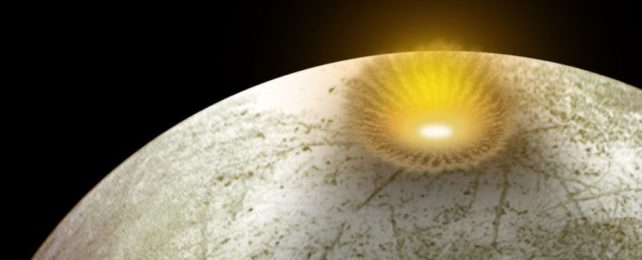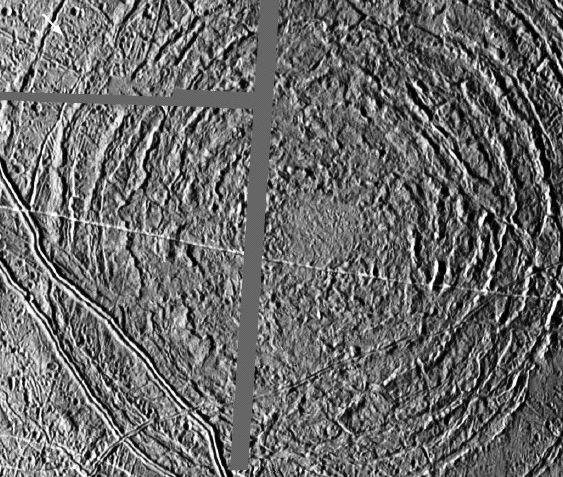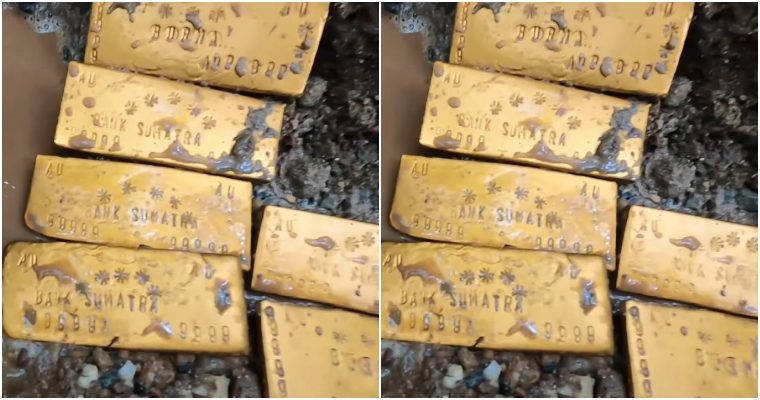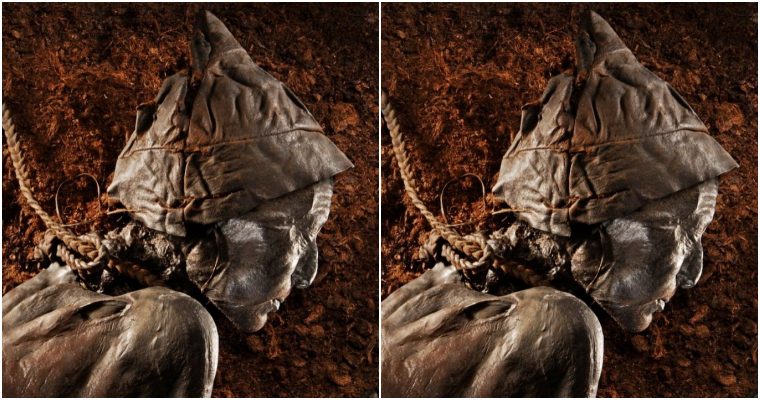
An artist’s impression of a comet striking Europa. (NASA/JPL-Caltech)
Comets, according to current theory, are a bit like cosmic storks that delivered the ingredients from which life could be made to a baby Earth billions of years ago.
Now, new research by scientists from the University of Texas, the California Institute of Technology, and Williams College has found that comets might play a similar role in delivering other life-giving compounds to other nearby worlds; in this case forcing reactive chemicals called oxidants through the icy crust and into the oceans of Jupiter’s moon Europa.

Even if the comet doesn’t entirely punch through the ice, its impact can help transport the oxidizing agents on Europa’s surface down to the liquid below, where they could help sustain any life that may be lurking down there in the dark.
Computer models show that an asteroid or comet’s impact only has to penetrate halfway through the 15 to 25 kilometer (10 to 15 mile)-thick ice to create a massive melt chamber that will continue the rest of the way.
“Once you get enough water, you’re just going to sink,” says computational engineer Evan Carnahan of the University of Texas at Austin. “It’s like the Titanic times 10.”

When it comes to finding life outside of Earth, even our very own Solar System presents a significant challenge. There’s simply nothing that has the unique conditions of our home world. Earth truly is one of a kind.
But there are worlds that could have the necessarily qualities that reflect life-sustaining environments on Earth. One of those is Europa, along with other icy moons – Saturn’s Titan and Enceladus.
These worlds are far from the Sun, and well outside the temperate habitable zone. But that freezing cold distance from the Sun, coupled with the extreme darkness of the oceanic depths, means that life wouldn’t be able to rely on a photosynthetic food web, as the vast majority of life on Earth does.
 Tyre, a large rippled impact crater on Europa. (NASA/JPL/DLR)
Tyre, a large rippled impact crater on Europa. (NASA/JPL/DLR)
However, some life does thrive in Earth’s light-starved depths. Clustered around hydrothermal vents that spew heat and chemicals from the ocean floor is an entire ecosystem based on chemosynthesis – harvesting chemical reactions, rather than sunlight, to produce energy.
Europa is thought to have hydrothermal vents powered by the stretching and compressing of the moon’s core by its gravitational interaction with Jupiter, generating an internal heat source.
But scientists believe that any carbon-based life therein may need oxidants to survive. These electron-receiving agents are produced on the surface of Europa by radiation and light from the Sun – but that’s of limited use to an ecosystem separated from the surface by a thick shell of ice.
One potential transport mechanism is comet and asteroid impacts, which would produce intense heat and melt the ice, allowing the oxidants to sink down. Europa does have some impact craters, after all, although not a huge number, because tectonic activity creates ice plumes and volcanoes that cover them up in pretty short order.
Nevertheless, the moon is no stranger to bombardment – and those impact craters that have been identified show concentric ripples that suggest significant melting followed by subsurface movement after the impact.
To determine whether these impacts would be sufficient to transport the oxidants, Carnahan and his team chucked mathematically simulated rocks at a simulated Europa, and observed the events following the impact. Rather than producing a shallow pocket of meltwater that then refroze, that meltwater – denser than the surrounding ice – sank downwards.
“We’re cautioning against the idea that you could maintain very large volumes of melt in the shallow subsurface without it sinking,” Carnahan says.
According to the team’s simulations, if that impact reaches halfway through Europa’s icy shell, 40 percent of the meltwater will eventually drain into the ocean. This has implications, not just for Europa, but also for other icy worlds with subsurface oceans.
“This study shows foundering of impact melts is a viable, robust, and likely widespread transport mechanism for surface materials to the ocean of Europa,” the researchers write in their paper.
“While this study has focused on Europa, the viscous foundering of impact melts to the ocean occurs for all ice shell thickness and ice viscosities explored here, and is therefore likely to occur on other icy worlds similar to Europa, for example, on Titan.”
The research has been published in Geophysical Research Letters.
source:sciencealert








